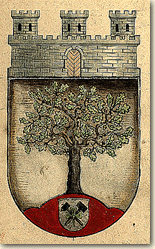Herne (Ruhr)
This page is part of the German heraldry portal Deutsche Wappensammlung |
Heraldry of the World |
|
German heraldry:
|
Selected collector's items from Germany:
|
HERNE
State : Nordrhein-Westfalen
Urban District (Stadtkreis) : Herne
Additions : 1908 Baukau, Horsthausen; 1975 Wanne-Eickel (1926 Wanne (1906 Crange), Eickel (1910 Holsterhausen), Röhlinghausen)
Official blazon
Origin/meaning
Herne was an unimportant village until the mining and industry started to develop in the last century. The village received city rights in 1897 and 0n July 30, 1900 the arms were granted by King Wilhelm II of Prussia. No arms or seals are known for Herne prior to 1900. In 1900 the arms were topped by a mural crown, which was officially abandoned on November 30, 1937, when new arms were granted.
| the official arms of 1900 |
The arms from 1937 |
The current arms were granted on January 1st, 1975. The arms combine the horse of Wanne-Eickel with the miner's tools from the older arms. The tree in the old arms is described as the tree of Westfalen, the area to which the city belongs. The meaning of the tree, however, is unknown. Westfalen uses a horse in its arms, no tree.
The small hill in the base of the arms is canting, Herne is supposedly derived from Hügel (hill).
The small shield in the base shows the miner's tools, obvious symbols for (at the time) a mining town. The trefoil is actually taken from the national symbol of Ireland. The trefoil, or shamrock in Irish-English, was taken as a canting symbol for the oldest mine, which (for unknown reason) was named Shamrock.
| Seal from around 1900 |
The arms by Hupp in the Kaffee Hag albums +/- 1925 |
The arms in the Abadie albums |
Contact and Support
Partners:
Your logo here ?
Contact us
© since 1995, Heraldry of the World, Ralf Hartemink 
Index of the site
Literature : Stadler, 1964-1971; new images taken from <a href=http://www.herne.de/stadt/stadtwappen.html-ssi>here]]

















